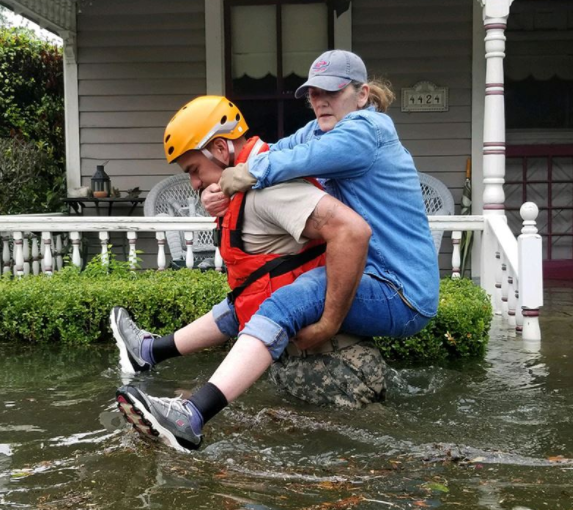
by Larry Magid

I’ve written my share of columns about social media, including stories about bullying, harassment, misogyny and other problems. But today’s column is decidedly positive. Facebook, Twitter, Nextdoor and mobile technology have, literally, been lifelines for victims of Hurricane and tropical storm Harvey.
There are numerous stories such as a woman in Houston who posted on Facebook that her sister’s family, including a one-year-old, needed to be rescued. And they were. Another woman received help after posting an address along with “Need help in NE Houston! Baby here and sick elderly!,” on Twitter.
Facebook’s has a community help page for Harvey, where people are posting updates, including both pleas and offers for help. As I was writing this column, someone posted about an “elderly handicap male wheelchair bound” person in Port Arthur, Texas who “needs assistance water in house.”
Listen to Larry’s 1-minute CBS News Radio segment on Harvey
Normally, people call for help by dialing 911 but that official emergency response system has been overwhelmed during this crisis. But social media doesn’t have the constraints of the 911 system, which is limited by the number of phone lines and the people available to answer them. With social media, help can be crowd sourced. Anyone who sees a public plea for help can respond by dispatching a rescuer in a small boat or large vehicle. These vehicles and vessels may not have red lights and sirens or any official status, but all that matters is whether they can get through the water and render aid.
Nextdoor, the popular neighborhood site that people typically use to seek out handymen or advertise stuff to give away, has come to the rescue. Nextdoor Vice President of Communications and Policy Steve Wymer told NPR that someone used Nextdoor to request an emergency rescue someone immediately responded, “Unloading my canoe now. I’m headed your way.”
Even law enforcement and other public officials have turned to social media to crowd-source help because their officers simply can’t respond to every request. Harris County Sheriff Ed Gonzalez took to Twitter on Sunday with the address of a woman who was going into labor. He later updated his followers that she had been picked up by an ambulance.
Officials are also using Twitter and other outlets to update residents on current conditions and imminent threats. It’s a lot more efficient that making thousands of robocalls to warn of imminent danger.
Of course, to use social media you need a working device that’s connected to a network. That can be challenging in any type of disaster when power lines, phone lines and broadband connections are often down. While hundreds of cell towers did fail during the storm, according to the Federal Communications Commission, most were able to stay online –- perhaps because they are typically up high on utility polls or tall towers and sometimes have backup power sources including solar and battery packs.
I maintain a web page (larrysworld.com/disaster) with advice on how to prepare for a power failure or disaster, which includes always having a charged-up battery backup for your phone. I also advise people to have a car adapter so they can charge their phone from a car’s power port if one is available. I also recommend that phones and laptops be fully charged ahead of any predicted outage and that people have flashlights, battery powered radios and batteries on-hand. Some devices, like the ER Emergency Ready 6N Solar/Hand-Crank Powered Emergency LED Flashlight and AM/FM Radio, can be charged by solar or by turning a crank. This $32 device can also be used to charge a cell phone.
Social media can also be used to let friends and loved-ones know you’re OK. Facebook initiates its safety check service whenever there is a natural or human disaster, including terror attacks and major weather events like Harvey. The company used to manually activate the feature but now it kicks in once “enough people in an area post about an incident.” Fortunately, I’ve never had to use this feature to tell friends I’m safe, but I used it this week to check on several friends in the Houston area and in the past, including just after terror attacks in Paris and Istanbul.
Mobile technology plays an important role not only by letting people send text messages, make calls and access social media but through specialized apps like Zello. Zello bills itself as a “walkie-talkie” app, but it’s more like a CB radio inside of a phone that enables people to use their voice to call for help, respond to calls and coordinate emergency responses. The Cajun Navy, volunteers who use private boats to rescue flood victims, has been using this service to coordinate its efforts. When I used the app on Monday, I heard someone say “I have someone needing rescue ASAP. It’s a pregnant woman and a child.” A few seconds later someone came to say that help was on the way.
You can complain all you want about social media as a platform for divisive political arguments, fake news and bullying, but it’s just a tool for humans to express what’s on their minds, whether good or bad or neutral. This week our thoughts turned away from our petty squabbles towards our collective concern for our fellow humans, and users of social media rose to the occasion. That’s something to “Like and Tweet about.
Larry Magid is a tech journalist and internet safety activist.